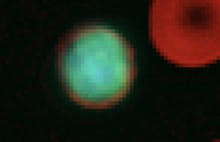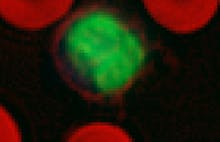Nucleated RBC (NRBC)
Definition, Ranges, And Causes
What Are Nucleated RBCs?
Nucleated RBCs are red blood cells with a nucleus. The nucleus, which contains DNA, should eject naturally as the cell develops in the bone marrow. When the nucleus has dissolved, the cell becomes more flexible. It will squeeze out of portholes in the bone marrow and enter the bloodstream.
The empty space in the cell then fills up with hemoglobin, an important protein which carries oxygen to tissues, and carries carbon dioxide back from tissues to the lungs to be breathed out.
What do nucleated RBCs indicate?
The presence of nucleated RBC can indicate a number of diseases or blood conditions, such as leukemia, anemia, or problems with the spleen.
A count of nucleated RBC might suggest that the body is so desperate for red blood cells that it has begun producing them outside of the bone marrow. Alternatively, it could indicate that there is damage to the blood-bone barrier, allowing these immature cells to escape from the marrow.
Both of these possibilities can be an aspect of serious health conditions. If the nucleated RBC reference range is higher than normal, further testing needs to be carried out.
What is the normal reference range for nucleated RBC?
The normal reference range for nucleated red blood cell is 0. Humans more than a few days old should not have any nucleated RBC in their bloodstream whatsoever.
Nucleated RBC are counted by the number of RBC per white blood cell (WBC). A normal nucleated RBC reference range for adults and children is a count of 0 nucleated RBC/100 WBC.
Having a count of nucleated RBC is a condition called normoblastemia. Even a count as low as 1/100 is abnormal and should be investigated. The presence of only a few nucleated red blood cells can indicate serious health issues.
The only time nucleated RBC is normal in humans is in infants for up to five days after birth, especially if they have growth issues or have experienced a lack of oxygen. Certain breeds of dogs, such as dachshunds, can also have a count of up to 7 nucleated RBC/100 WBC without cause for concern.
However, in healthy adults and children, nucleated RBC should only be found in the bone marrow.
What causes Nucleated RBC?
Normoblastemia can be caused by several blood diseases and health conditions. These include:
- Bone marrow damage
When the bone marrow is damaged, the blood-bone barrier can become weak and let nucleated RBC slip into the bloodstream. Conditions that damage the bone marrow include blood cancers such as leukemia and lymphoma, tuberculosis, and certain fungal infections.
- RBC production outside of the bone marrow
Bone marrow damage or anemia may cause the body to compensate by making RBC in locations other than the bone marrow, for example in the liver or spleen. These conditions can include leukemia, myeloid metaplasia (scarring of the bone marrow), and polycythemia vera (excessive RBC production).
- Spleen dysfunction
Sometimes nucleated RBC do slip out of the bone marrow in healthy humans. It is the spleen’s job to clear them from the blood. However, medical issues that affect the spleen can prevent this from happening.
Such issues include certain types of anemia, malaria, collagen vascular diseases, malignant neoplasms, and chemotherapy treatment. Normoblastemia can be a sign of splenic failure.
- Low oxygen
All types of anemia reduce blood cells’ ability to carry oxygen through the body, causing tissues to go into a state of hypoxia. This means the body begins overproducing blood cells outside of the bone marrow.
Along with anemia, hypoxia can be caused by blood loss, heart failure, or lung disease.
Discover the automated CBC analyzer - Sight OLO
Disclaimer: The content of this knowledge post intends to provide general information related to topics that are relevant to blood diagnostics and may not be used in relation to the operation of Sight OLO. For detailed information on the diagnostic parameters and specifications of Sight OLO, please refer to the official Operator's Manual.

